In Greek there is the word "scolios", which is translated as "crooked".In this word, the doctor marks the curvature of the spinal column.Also, not all curvature, which is the vertical side of the spine.In fact, our spine is usually not perfect though.The bends in front and back (lordoses and kyphosis) protect our spine from excess load while keeping the body in certain positions when moving and heavy.The negative processes in our body only develop in cases where kyphoses and masters are stated beyond the allowable norms.
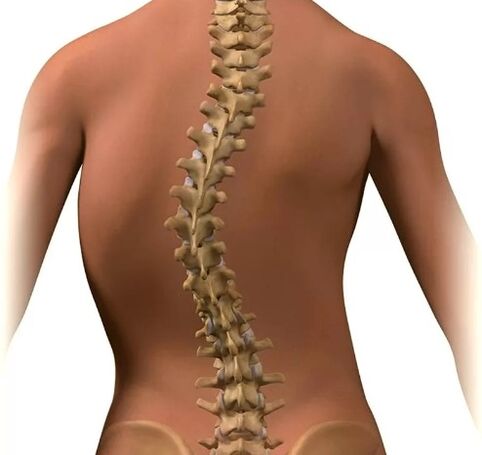
A major problem
However, even the slightest bend (scoliosis) of the spine is always pathological.And it means not only in cosmetic defects.Despite the disgusting appearance of the features with spoken or progressive scoliosis it is always a tragedy for someone who strives to live a high life.This is especially true for boys and girls.Indeed, in children and youth (up to 15 - 16 years) that most scoliosis is diagnosed.
The main problem is due to changes in configuration and chest volume with spoken side curvature, internal organs are always suffering (heart, lungs, stomach, liver, intestines, large vessels).In men, tolerance to physical decline, women have problems with conception, which have pregnancy and childbirth.Furthermore, the lateral spinal cord is just the surface of the mountain of the ice, which is a more serious sign of pathology - tumor, tuberculosis, endocrine disorders.
Cause
So why is the spine defective?Before answering the question, you should decide on the type of scoliosis.At its core, scoliosis can be a structure and not a structure.Structural scoliosis develops due to anatomical changes in the structure of the vertebral bone, as well as the muscles, nerves, and nearby ligaments.Such curvature can be obtained and congenital, and about a quarter of all scoliosis accounts diagnosed for the last.
Among the main reasons for the development of structural scoliosis, they distinguish:
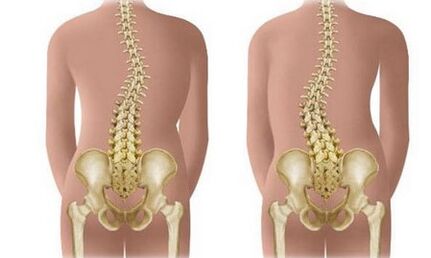
- A pole of intrauterine development leading to a displaced displacement of one or more vertebrae
- Abnormalities of congenital chest development - lack of ribs, extra ribs
- Congenital pathology of connective tissue - neurofibromatosis, marfan syndrome
- Brain failure due to paralysis of children (cerebral palsy), which leads to a violation of certain parts of the spine
- Osteoporosis (bone -tissue) spine in rickets, parathyroid gland disease, lack of calcium intake with food
- Osteomyelitis from vertebrae
- Dystrophic changes in cervical, thoracic and lumbar muscles
- Tuberculosis damage to the vertebrae
- Spinal injury
- Spinal tumor.
Non -structural scoliosis, as follows from a very name, is a deviation of the spinal column side with the unchanged vertebral structure.As a rule, such scoliosis is most often obtained with the exception of cases where curvature is compensated with congenital anatomical defects of the pelvis or lower leg.The cause of such scoliosis is most often:
- Pelvic injury and lower leg
- Congenital defects of the pelvis and lower leg
- Incorrect posture in school
- Internal organ disease with accidental pain syndrome
- Muscle inflammation (myosites)
- Burns, grated soft cloth on one side.
In these cases, to eliminate spinal curvature, it is sufficient to cure underlying diseases, and therefore many unstructural scoliosis is easily reversed.In this case, some doctors tend to not consider unstructural deformation for scoliosis in general.
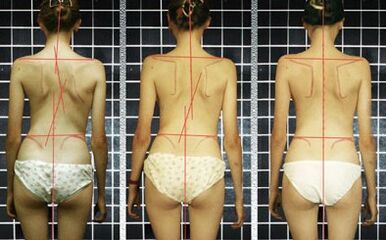
Recently, the cases of scoliosis development for unclear reasons have become more frequent.This is idiopathic scoliosis.It occurs in the years of youth, during the rapid growth period.Moreover, children have idiopathic scoliosis several times more often than young men.Apparently, this is caused by a relatively weak muscle in the back of the woman, which cannot attach the spine in the full muscle frame.Unbalanced diets with low calcium salts, and general enthusiasm for youth with carbonated drinks play a final role in the development of idiopathic scoliosis.As you know, carbon dioxide in bubbles and orthophosphoric acid in synthetic entry contributes to the solution of calcium salts from the body.
Varieties and degrees
Depending on the localization, scoliosis can be cervical, chest, lumbar or mixed (cervical, lumbosacral).It is possible to have one or more curvature arcs.In this case, C -shaped scoliosis (with 1 arc), S -shaped (with 2 arcs) and Z -shaped (with 3 arcs) is distinguished.Most likely, the presence of 2 or 3 arcs is compensation.With C -shaped scoliosis, the spinal column axis deviates.In an effort to balance this, the spine bends in the opposite direction.In this case, scoliosis is divided into compensation and not compensated.In compensated spinal curvature, the vertical line is lowered from the cervical vertebra to the 7 through the folds between the back.
Spinal curvature is often combined.For example, in the thoracic region, in addition to side curvature, pathological kyphosis is observed, or just bumps.In this case, talk about thoracic kyphoscoliosis.In addition, with large levels of scoliosis, in addition to the lateral displacement of the vertebra, Thuria is observed.In literary translation, this means turning around.Indeed, with many scoliosis, vertebral bone tissue is twisted throughout the vertical axis.
Depending on the size of the curvature arc, 4 degrees scoliosis is distinguished:
- 1 degree- The curvature angle does not exceed 10 degrees.Asymmetry by the eye is practically unspecified.The field, the unequal level of the shoulder, pay attention.
- 2 degrees- The curvature angle is from 11 to 25 degrees.At this stage, the vertebra has been observed.There is a shoulder and pelvic asymmetry that can be seen in the eyes.Due to pathological muscle tension, muscle roller is formed in the lumbar region from the concave side, and in the convex area.
- 3 degrees- Wrifications are from 26 to 50 degrees.Chest modification - west of the intercostal space C on the concave side of the curvature and bulge with convex.Weaknesses of the abdominal newspaper, the formation of internal bumps.
- 4 degrees- The angle of my curvature exceeds 50 degrees.Cosmetic defects and all previous signs are specified.Low tolerance even small work.In addition to the musculoskeletal system, the internal organs suffer.
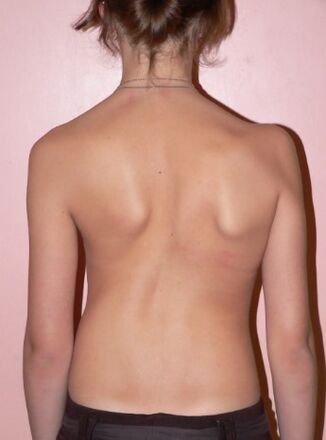
The angle may vary -depending on the position of the body, while the scoliosis is stable and unstable.With unstable scoliosis, it decreases in position as the load on the spinal column decreases.With stable spinal curvature, this value remains unchanged.
Symptom
Recently, orthopedists often use the term "scoliotic disease".And they show the complex of negative changes that occur in the body during spinal curvature.As a rule, scoliotic disease develops in children and adolescents, during the formation of the musculoskeletal system.Currently, there is a high probability that scoliosis will develop.
Apparently, the intervertebral disc plays an important role in increasing the angle of curvature.With side -by -side displacement, the disc is undergoing uneven pressure from the vertebral body.On the concave side, the pressure is larger, with convex - less.As a result, the disc wears more than scoliosis, pathological muscle tension (muscle roller) and vertebral torsion are created - all of which lead to the appearance of disc hernia and further improvement in the angle of curvature.
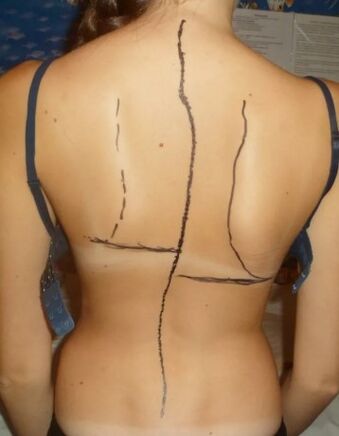
Along with the spine with scoliotic disease, the chest changes second.The ribs are formed - on the convex side of the curvature, the intercostal space develops, and from the concave - instead, they are sown.With the 4th degree scoliosis, the chest deformation is so clear that the lower ribs on the side of the curvature come in contact with the iliac bone.
Due to severe chest deformation, full visits during breathing are difficult.As a result, the body with severe scoliosis does not receive the required amount of oxygen - chronic hypoxia formed by violating all metabolic processes in the body.This pathology is worsened by the fact that the internal volume and form of change in the chest cavity.Therefore, blood circulation through the vessels is disrupted, the lungs suffer, the form of heart change, chronic cardiovascular failure develops.
The same changes occur in the abdominal organs for lumbar and lumbosacral scoliosis.Motoric stomach and intestines are reduced by enzymatic deficiency of the digestive gland.All of these only worsen metabolic disorders.These violations often cause sexual maturation of men and women.In addition, due to lumbar scoliosis, the pelvis is curved a second time.This causes problems for future mothers with pregnancy and childbirth.
Diagnostics
Diagnosis of scoliosis, especially large degrees, as a rule, is not difficult.To detect spinal deformation, regular visual examinations are quite often.The contour curvature visible from the spine, the asymmetry of the shoulder, the shoulder blade angle, the secondary curvature of the pelvis and the shortening of the lower limbs on the side of the curvature.
With the presence of at least one of these marks, the radiograph of the spinal column is indicated.X -ray determines configuration, degree and localization of curvature.During radiological examination and examination, it is possible to determine whether scoliosis is compensated and stable.Recently, a new qualitative research method on magnetic resonance imaging (MRI) has been spread, where three-dimensional images can be obtained on the monitor screen.With significant curvature, it is necessary to investigate the functioning of the internal organs - to perform spirometry, electrocardiography, and perform heart ultrasound and internal organs.
Treatment
Treatment of scoliosis can be done conservatively and immediately.Conservative methods include drug treatment, massage, physiotherapy procedures, and manual therapy.Keep in mind that the last formation of the spine ends at the age of 20, and after this age, curvature correction is almost impossible.With 1-2 degrees scoliosis, the effort is intended to achieve the initial configuration of the spine.With the scoliosis mentioned in the 3rd -4th stages, this is not achieved, the main thing here is to stabilize the spine and prevent the development of scoliosis.

Medications (chondroprotectors, vitamins, general reinforcement drugs) in the treatment of scoliosis play an additional role.To strengthen the muscles, eliminate muscle roller, and also most to stabilize the spine with the help of massage and manual therapy.Good effects are given by physiotherapy training.But here, with inadequate physical energy, spinal instability is enhanced and scoliosis lasts.Therefore, a set of exercises are developed for each patient individually, taking into account localization and severity of curvature.With large levels of scoliosis, walking, strength training, jumping, external games are contraindicated.
Excellent results provide correction by position - optimal pose created that contributes to the normalization of posture.For this, a special device is used, an orthopedic swing in which young patients spend most of their time.With ineffective steps -Conservative steps, curvature development, surgical treatment aimed at stabilizing the spine is indicated.Surgical correction was not shown in the childhood, it was carried out in adolescence, when the spinal formation was almost complete.

















































